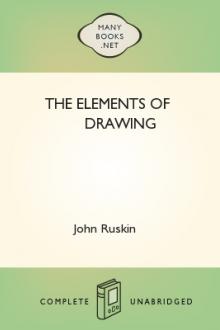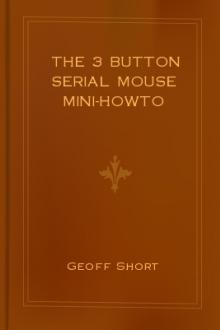The Elements of Drawing by John Ruskin (smart books to read .txt) 📕

- Author: John Ruskin
- Performer: -
Book online «The Elements of Drawing by John Ruskin (smart books to read .txt) 📕». Author John Ruskin
116. Thirdly. When you have neither time for careful study nor for Düreresque detail, sketch the outline with pencil, then dash in the shadows with the brush boldly, trying to do as much as you possibly can at once, and to get a habit of expedition and decision; laying more color again and again into the tints as they dry, using every expedient which your practice has suggested to you of carrying out your chiaroscuro in the manageable and moist material, taking the color off here with the dry brush, scratching out lights in it there with the wooden handle of the brush, rubbing it in with your fingers, drying it off with your sponge, etc. Then, when the color is in, take your pen and mark the outline characters vigorously, in the manner of the Liber Studiorum. This kind of study is very convenient for carrying away pieces of effect which depend not so much on refinement as on complexity, strange shapes of involved shadows, sudden effects of sky, etc.; and it is most useful as a safeguard against any too servile or slow habits which the minute copying may induce in you; for although the endeavor to obtain velocity merely for velocity's sake, and dash for display's sake, is as baneful as it is despicable; there are a velocity and a dash which not only are compatible with perfect drawing, but obtain certain results which cannot be had otherwise. And it is perfectly safe for you to study occasionally for speed and decision, while your continual course of practice is such as to insure your retaining an accurate judgment and a tender touch. Speed, under such circumstances, is rather fatiguing than tempting; and you will find yourself always beguiled rather into elaboration than negligence.
Fig. 21. Fig. 21.117. Fourthly. You will find it of great use, whatever kind of landscape scenery you are passing through, to get into the habit of making memoranda of the shapes of shadows. You will find that many objects of no essential interest in themselves, and neither deserving a finished study, nor a Düreresque one, may yet become of singular value in consequence of the fantastic shapes of their shadows; for it happens often, in distant effect, that the shadow is by much a more important element than the substance. Thus, in the Alpine bridge, Fig. 21, seen within a few yards of it, as in the figure, the arrangement of timbers to which the shadows are owing is perceptible; but at half a mile's distance, in bright sunlight, the timbers would not be seen; and a good painter's expression of the bridge would be merely the large spot, and the crossed bars, of pure gray; wholly without indication of their cause, as in Fig. 22 a; and if we saw it at still greater distances, it would appear, as in Fig. 22 b and c, diminishing at last to a strange, unintelligible, spider-like spot of gray on the light hill-side. A perfectly great painter, throughout his distances, continually reduces his objects to these shadow abstracts; and the singular, and to many persons unaccountable, effect of the confused touches in Turner's distances, is owing chiefly to this thorough accuracy and intense meaning of the shadow abstracts.
Fig. 22. Fig. 22.118. Studies of this kind are easily made, when you are in haste, with an F. or HB. pencil: it requires some hardness of the point to insure your drawing delicately enough when the forms of the shadows are very subtle; they are sure to be so somewhere, and are generally so everywhere. The pencil is indeed a very precious instrument after you are master of the pen and brush, for the pencil, cunningly used, is both, and will draw a line with the precision of the one and the gradation of the other; nevertheless, it is so unsatisfactory to see the sharp touches, on which the best of the detail depends, getting gradually deadened by time, or to find the places where force was wanted look shiny, and like a fire-grate, that I should recommend rather the steady use of the pen, or brush, and color, whenever time admits of it; keeping only a small memorandum-book in the breast-pocket, with its well-cut, sheathed pencil, ready for notes on passing opportunities: but never being without this.
119. Thus much, then, respecting the manner in which you are at first to draw from Nature. But it may perhaps be serviceable to you, if I also note one or two points respecting your choice of subjects for study, and the best special methods of treating some of them; for one of by no means the least difficulties which you have at first to encounter is a peculiar instinct, common, as far as I have noticed, to all beginners, to fix on exactly the most unmanageable feature in the given scene. There are many things in every landscape which can be drawn, if at all, only by the most accomplished artists; and I have noticed that it is nearly always these which a beginner will dash at; or, if not these, it will be something which, though pleasing to him in itself, is unfit for a picture, and in which, when he has drawn it, he will have little pleasure. As some slight protection against this evil genius of beginners, the following general warnings may be useful:
120. (1.) Do not draw things that you love, on account of their associations; or at least do not draw them because you love them; but merely when you cannot get anything else to draw. If you try to draw places that you love, you are sure to be always entangled amongst neat brick walls, iron railings, gravel walks, greenhouses, and quickset hedges; besides that you will be continually led into some endeavor to make your drawing pretty, or complete, which will be fatal to your progress. You need never hope to get on, if you are the least anxious that the drawing you are actually at work upon should look nice when it is done. All you have to care about is to make it right, and to learn as much in doing it as possible. So then, though when you are sitting in your friend's parlor, or in your own, and have nothing else to do, you may draw anything that is there, for practice; even the fire-irons or the pattern on the carpet: be sure that it is for practice, and not because it is a beloved carpet, or a friendly poker and tongs, nor because you wish to please your friend by drawing her room.
121. Also, never make presents of your drawings. Of course I am addressing you as a beginner—a time may come when your work will be precious to everybody; but be resolute not to give it away till you know that it is worth something (as soon as it is worth anything you will know that it is so). If any one asks you for a present of a drawing, send them a couple of cakes of color and a piece of Bristol board: those materials are, for the present, of more value in that form than if you had spread the one over the other.
The main reason for this rule is, however, that its observance will much protect you from the great danger of trying to make your drawings pretty.
122. (2.) Never, by choice, draw anything polished; especially if complicated in form. Avoid all brass rods and curtain ornaments, chandeliers, plate, glass, and fine steel. A shining knob of a piece of furniture does not matter if it comes in your way; but do not fret yourself if it will not look right, and choose only things that do not shine.
(3.) Avoid all very neat things. They are exceedingly difficult to draw, and very ugly when drawn. Choose rough, worn, and clumsy-looking things as much as possible; for instance, you cannot have a more difficult or profitless study than a newly painted Thames wherry, nor a better study than an old empty coal-barge, lying ashore at low tide: in general, everything that you think very ugly will be good for you to draw.
(4.) Avoid, as much as possible, studies in which one thing is seen through another. You will constantly find a thin tree standing before your chosen cottage, or between you and the turn of the river; its near branches all entangled with the distance. It is intensely difficult to represent this; and though, when the tree is there, you must not imaginarily cut it down, but do it as well as you can, yet always look for subjects that fall into definite masses, not into network; that is, rather for a cottage with a dark tree beside it, than for one with a thin tree in front of it, rather for a mass of wood, soft, blue, and rounded, than for a ragged copse, or confusion of intricate stems.
(5.) Avoid, as far as possible, country divided by hedges. Perhaps nothing in the whole compass of landscape is so utterly unpicturesque and unmanageable as the ordinary English patchwork of field and hedge, with trees dotted over it in independent spots, gnawed straight at the cattle line.
Still, do not be discouraged if you find you have chosen ill, and that the subject overmasters you. It is much better that it should, than that you should think you had entirely mastered it. But at first, and even for some time, you must be prepared for very discomfortable failure; which, nevertheless, will not be without some wholesome result.
123. As, however, I have told you what most definitely to avoid, I may, perhaps, help you a little by saying what to seek. In general, all banks are beautiful things, and will reward work better than large landscapes. If you live in a lowland country, you must look for places where the ground is broken to the river's edges, with decayed posts, or roots of trees; or, if by great good luck there should be such things within your reach, for remnants of stone quays or steps, mossy mill-dams, etc. Nearly every other mile of road in chalk country will present beautiful bits of broken bank at its sides; better in form and color than high chalk cliffs. In woods, one or two trunks, with the flowery ground below, are at once the richest and easiest kind of study: a not very thick trunk, say nine inches or a foot in diameter, with ivy running up it sparingly, is an easy, and always a rewarding subject.
124. Large nests of buildings in the middle distance are always beautiful, when drawn carefully, provided they are not modern rows of pattern cottages, or villas with Ionic and Doric porticoes. Any old English village, or cluster of farmhouses, drawn with all its ins and outs, and haystacks, and palings, is sure to be lovely; much more a French one. French landscape is generally as much superior to English as Swiss landscape is to French; in some respects, the French is incomparable. Such scenes as that avenue on the Seine, which I have recommended you to buy the engraving of, admit no rivalship in their expression of graceful rusticity and cheerful peace, and in the beauty of component lines.
In drawing villages, take great pains with the gardens; a rustic garden is in every way beautiful. If you have time, draw all the rows of cabbages, and hollyhocks, and broken fences, and wandering eglantines, and bossy roses; you cannot have better practice, nor be kept by anything in purer thoughts.
Make intimate friends with all the brooks in your neighborhood, and study them ripple by





Comments (0)